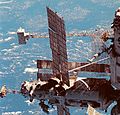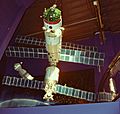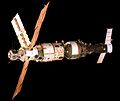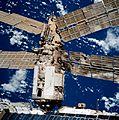Mir facts for kids
Mir (which means "peace" or "world" in Russian) was a famous space station. It orbited Earth from 1986 to 2001. The Soviet Union built and operated it, and later Russia took over. Mir was special because it was the first space station made of different parts, like building blocks. Astronauts assembled these parts in space between 1986 and 1996.
For a long time, Mir was the largest artificial satellite orbiting our planet. It was later replaced by the International Space Station (ISS). On Mir, crews worked in a special microgravity research laboratory. They did many experiments in biology, physics, astronomy, and meteorology. Their main goal was to learn how to live and work in space for long periods.
Mir was the first space station where people lived and worked continuously for a long time. It held the record for the longest time humans stayed in space without a break: 3,644 days! The International Space Station broke this record on October 23, 2010. Mir also holds the record for the longest single spaceflight by one person. Valeri Polyakov spent an amazing 437 days and 18 hours on the station from 1994 to 1995. Mir had people living on it for about twelve and a half years out of its fifteen-year life. It could hold a crew of three astronauts or cosmonauts for long stays, and even more for short visits.
Contents
Building the Mir Space Station
The Mir station was the next big step after the successful Salyut programme of space stations. The very first part of Mir, called the core module or base block, was launched into space in 1986. After that, six more modules were added over time.
How Modules Were Launched
Most of Mir's parts were launched using powerful Proton rockets. However, one special part, the docking module, was installed by a US Space Shuttle mission called STS-74 in 1995. When it was finished, Mir had seven main sections where people could live and work. It also had other parts that were not pressurized.
Powering the Station
Mir got its power from several large solar panels. These panels were attached directly to the different modules. They turned sunlight into electricity, which was essential for everything on the station.
Mir's Orbit and Speed
The station orbited Earth at an altitude between 296 kilometers (184 miles) and 421 kilometers (262 miles). It moved incredibly fast, at an average speed of 27,700 kilometers per hour (17,200 mph)! This meant Mir completed about 15.7 orbits around Earth every single day.
Life and End of Mir
Mir was launched as part of the Soviet Union's plan to have a long-term research outpost in space. After the Soviet Union broke apart, the new Russian Federal Space Agency (RKA) took over its operation.
International Cooperation
Most of the people who lived on Mir were Soviet or Russian. But through special international programs like Intercosmos, Euromir, and the Shuttle–Mir programs, astronauts and cosmonauts from many other countries also visited. People from Asia, Europe, and North America got to experience life on Mir.
The End of an Era
Mir was finally taken out of orbit in March 2001. This happened because funding for the station was cut. The entire Mir program, including its development, assembly, and years of operation, cost about $4.2 billion. This was a huge amount of money, but Mir gave us so much knowledge about living in space.
Images for kids
-
Shannon Lucid exercises on a treadmill during her stay aboard Mir.
-
One of the space toilets used aboard Mir
-
Space Shuttle Atlantis docked to Mir on STS-71.
-
Mir breaks up in Earth's atmosphere over the South Pacific on 23 March 2001.
-
Soyuz TM-24 docked with Mir as seen from the Space Shuttle Atlantis during STS-79
-
Picture of the damage caused by the collision with Progress M-34. Picture was taken by Space Shuttle Atlantis during STS 86
See also
 In Spanish: Mir (estación espacial) para niños
In Spanish: Mir (estación espacial) para niños























